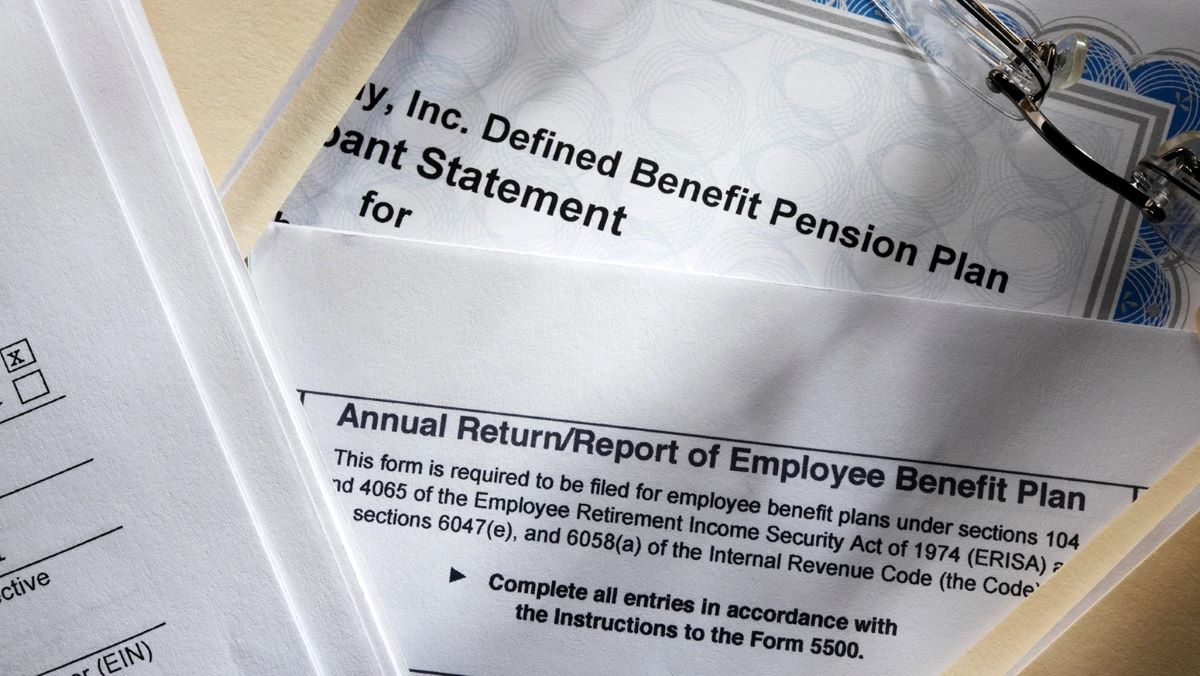

Finance
What Is State Compensation Insurance Fund
Published: November 23, 2023
Learn about the State Compensation Insurance Fund and its role in providing financial support for workers' compensation in California. Explore the finance aspect of this government agency and its impact on businesses and employees.
(Many of the links in this article redirect to a specific reviewed product. Your purchase of these products through affiliate links helps to generate commission for LiveWell, at no extra cost. Learn more)
Table of Contents
- Introduction
- Definition of State Compensation Insurance Fund
- Purpose of State Compensation Insurance Fund
- History of State Compensation Insurance Fund
- Funding of State Compensation Insurance Fund
- Operations and Services Provided by State Compensation Insurance Fund
- Coverage and Benefits Offered by State Compensation Insurance Fund
- Eligibility and Requirements for State Compensation Insurance Fund
- Comparison of State Compensation Insurance Fund with Private Insurance Companies
- Criticisms and Controversies Surrounding State Compensation Insurance Fund
- Future Outlook and Challenges for State Compensation Insurance Fund
- Conclusion
Introduction
The State Compensation Insurance Fund, often referred to as State Fund, is a public enterprise that operates as the leader in providing workers’ compensation insurance in the state of California. Established in 1914, State Fund was created to provide a reliable and affordable option for employers to obtain workers’ compensation insurance for their employees.
Workers’ compensation insurance is a crucial component of the social safety net, as it protects employees who are injured or become ill on the job. It provides medical care, wage replacement, and rehabilitation services to injured workers and protects employers from potential lawsuits related to workplace injuries.
The purpose of State Fund is to ensure that all workers in California have access to workers’ compensation insurance, regardless of the size or nature of their employer’s business. By offering coverage to a wide range of industries, State Fund plays a vital role in promoting the welfare and stability of the workforce in the state.
State Fund operates as a quasi-state agency, with a governing board appointed by the Governor of California. Although it is a government entity, State Fund operates on a self-sustaining basis, relying on premium revenue and investment income to cover its operating expenses and claims. As a result, it does not rely on taxpayer dollars to fund its operations.
Over the years, State Fund has earned a reputation as a reliable and financially stable provider of workers’ compensation insurance. It has established a vast network of partnerships with insurance brokers and agents, enabling it to effectively reach and serve both small and large businesses throughout the state.
In the following sections, we will explore the history of State Fund, its funding model, the operations and services it provides, the coverage and benefits it offers, and the eligibility and requirements for obtaining State Fund insurance. We will also examine how State Fund compares to private insurance companies, address any criticisms or controversies surrounding its operations, and discuss the future challenges and opportunities for this vital institution.
Definition of State Compensation Insurance Fund
The State Compensation Insurance Fund, commonly known as State Fund, is a public enterprise that provides workers’ compensation insurance in the state of California. It is a government-operated entity and is one of the largest workers’ compensation insurers in the state.
State Fund was established in 1914 following the passage of the Workers’ Compensation Act in California. Its primary purpose is to ensure that employers have access to workers’ compensation insurance to protect their employees in the event of work-related injuries or illnesses.
Workers’ compensation insurance is a mandatory requirement for all employers in California, and State Fund offers a reliable and cost-effective option for businesses to comply with this legal obligation. Employers can purchase coverage directly from State Fund or through licensed insurance brokers and agents.
State Fund operates on a not-for-profit basis, meaning that its focus is on serving its policyholders rather than generating profits. As a public entity, it is governed by a board of directors appointed by the Governor of California. The board is responsible for setting policy and overseeing the operations of State Fund.
State Fund plays a vital role in the workers’ compensation system in California. It provides the necessary financial resources to cover medical expenses, disability benefits, vocational rehabilitation, and other related costs for employees who suffer work-related injuries or illnesses. By ensuring that injured workers receive the care and support they need, State Fund contributes to the overall well-being of California’s workforce.
It is important to note that while State Fund is a significant provider of workers’ compensation insurance, it is not the only option available to employers in California. Private insurance companies also offer workers’ compensation coverage, and employers have the choice to obtain insurance from State Fund or through these private carriers.
In the following sections, we will explore the purpose of State Fund, its history, how it is funded, the various operations and services it provides, the coverage and benefits it offers, as well as the eligibility requirements for obtaining State Fund insurance. We will also compare State Fund with private insurance companies and discuss any criticisms or controversies surrounding its operations.
Purpose of State Compensation Insurance Fund
The State Compensation Insurance Fund, also known as State Fund, serves a crucial purpose in the workers’ compensation system of California. Its primary objective is to ensure that all employers in the state have access to affordable workers’ compensation insurance coverage for their employees.
One of the main purposes of State Fund is to provide a stable and reliable source of workers’ compensation insurance to businesses of all sizes and across various industries. By offering coverage options to a wide range of employers, including those in high-risk industries, State Fund helps to mitigate the financial burden and potential liabilities associated with workplace injuries and illnesses.
State Fund plays a vital role in protecting both employers and employees. By providing workers’ compensation insurance, it ensures that injured workers receive prompt and appropriate medical care, rehabilitation services, and wage replacement benefits. This not only helps injured employees recover and return to work but also provides financial security and peace of mind to their families.
Another important purpose of State Fund is to help maintain a stable and equitable workers’ compensation system in California. State Fund operates on a purely not-for-profit basis, meaning that its focus is on serving its policyholders rather than generating profits. This allows State Fund to offer competitive rates and stable premiums, ensuring that workers’ compensation insurance remains accessible and affordable for businesses throughout the state.
Moreover, State Fund actively collaborates with employers to promote safety measures in the workplace. It provides resources and expertise in risk management to help businesses prevent accidents, reduce injuries, and create a safer work environment. By doing so, State Fund not only reduces the number of workplace injuries but also helps employers control their workers’ compensation costs in the long run.
State Fund also supports economic growth and stability in California. By providing a reliable and cost-effective option for employers to obtain workers’ compensation insurance, State Fund helps businesses thrive and create job opportunities. The availability of affordable workers’ compensation coverage through State Fund ensures that employers can focus on their core operations without any undue financial burdens related to workplace injuries.
In summary, the purpose of State Compensation Insurance Fund is to provide accessible, affordable, and reliable workers’ compensation insurance to employers in California. By offering comprehensive coverage, supporting workplace safety measures, and promoting economic stability, State Fund plays a critical role in protecting the rights and well-being of both employers and employees in the state.
History of State Compensation Insurance Fund
The State Compensation Insurance Fund, often referred to as State Fund, has a rich history dating back to its establishment in 1914. It was created in response to the growing need for workers’ compensation insurance following the enactment of the Workers’ Compensation Act in California.
Before the establishment of State Fund, employers in California relied on private insurers for workers’ compensation coverage. However, small businesses and high-risk industries often struggled to obtain affordable insurance, leading to concerns about the fairness and effectiveness of the system.
In order to ensure that all employers had access to workers’ compensation insurance, the California Legislature passed a law authorizing the creation of a state-operated insurance fund. This fund would provide a stable and accessible source of workers’ compensation coverage for employers who could not obtain coverage from private insurers.
On September 1, 1914, State Compensation Insurance Fund officially began operations. Its mission was to provide an alternative option for employers to obtain workers’ compensation insurance in a fair and efficient manner.
Over the years, State Fund has grown and evolved to meet the changing needs of California’s workforce. It has expanded its reach to cover a wide range of industries, including high-risk sectors such as construction, healthcare, and agriculture.
Throughout its history, State Fund has played a significant role in shaping the workers’ compensation landscape in California. It has been at the forefront of implementing reforms and innovations to improve the system’s efficiency and effectiveness.
One notable milestone in the history of State Fund occurred in 2004 when the California Legislature enacted Senate Bill 899, a landmark workers’ compensation reform package. This reform aimed to address rising costs and streamline the claims process. State Fund actively supported these reforms and implemented various initiatives to improve its operations and better serve its policyholders.
Today, State Compensation Insurance Fund continues to be a leader in the workers’ compensation insurance industry. It remains committed to its founding principles of providing affordable and reliable coverage for employers and ensuring that injured workers receive the care and support they need.
With a history spanning over a century, State Fund has established itself as a trusted and stable provider of workers’ compensation insurance in California. It continues to adapt to the ever-changing needs of the workforce and remains dedicated to upholding its mission of promoting the safety and well-being of employers and employees alike.
Funding of State Compensation Insurance Fund
The State Compensation Insurance Fund, commonly known as State Fund, operates on a self-sustaining financial model. It is not funded by taxpayer dollars but instead relies on multiple sources of revenue to cover its operating expenses and claims.
One of the primary sources of funding for State Fund is the premiums paid by policyholders. Employers who obtain workers’ compensation insurance from State Fund contribute premiums based on the size of their payroll and the level of risk associated with their industry. These premiums are set based on actuarial calculations and are adjusted periodically to ensure that they reflect the true cost of providing coverage.
In addition to premiums, State Fund also generates income through investment returns. It strategically manages its financial assets to generate income that can be used to supplement its operations and offset any potential deficits.
State Fund also receives reimbursements from the California Insurance Guarantee Association (CIGA) for claims related to insolvent private insurance carriers. When a private insurance carrier becomes insolvent, CIGA is responsible for covering the outstanding claims of their policyholders. State Fund, in turn, files claims with CIGA for the portion of these claims that it has paid as a result of being the insurer of last resort.
In certain cases, State Fund may also receive reimbursement from other insurance carriers through the Subsequent Injuries Benefits Trust Fund (SIBTF). SIBTF reimburses State Fund for the share of benefits provided to injured workers with pre-existing disabilities who subsequently suffer a work-related injury.
It is important to note that while State Fund operates as a not-for-profit entity, it does maintain a surplus fund. The surplus fund serves as a reserve to ensure that State Fund can meet its obligations and provide stability in times of high claim activity or economic downturns. The surplus is carefully managed and regulated to ensure that it remains at an appropriate level and can be used to protect policyholders.
Overall, the funding of State Compensation Insurance Fund relies on the contributions from policyholders’ premiums, investment returns, reimbursements from CIGA and SIBTF, and the careful management of its surplus fund. By diversifying its revenue streams, State Fund ensures that it can continue to provide affordable and quality workers’ compensation insurance to employers in California.
Operations and Services Provided by State Compensation Insurance Fund
The State Compensation Insurance Fund, also known as State Fund, operates as a full-service workers’ compensation insurance provider in the state of California. It offers a wide range of operations and services to serve the needs of employers and injured workers throughout the state.
One of the primary operations of State Fund is underwriting workers’ compensation insurance policies. Employers can obtain insurance coverage directly from State Fund or through licensed insurance brokers and agents. State Fund assesses the risk associated with each employer and determines the appropriate premium based on factors such as the size of the payroll, industry classification, and safety record.
State Fund also provides claims management services. When an employee suffers a work-related injury or illness, State Fund manages the entire claims process. This includes receiving and reviewing the claim, coordinating medical treatment, determining the eligibility for benefits, and processing the necessary payments for medical expenses and wage replacement.
In addition to claims management, State Fund offers comprehensive medical management services. It works closely with healthcare providers and networks to ensure injured workers receive appropriate and timely medical treatment. This includes facilitating access to quality healthcare providers, coordinating specialized care, and overseeing the utilization of medical services to promote the best possible outcomes for injured workers.
State Fund recognizes the importance of returning injured workers to the workforce as soon as it is medically feasible. Therefore, it provides vocational rehabilitation services to help injured workers transition back to suitable employment. These services may include job retraining, job placement assistance, and vocational counseling to facilitate a smooth and successful return to work.
Furthermore, State Fund places a strong emphasis on safety and loss prevention. It offers a variety of resources and programs to help employers create safe work environments and reduce workplace injuries. This includes providing safety trainings, educational materials, and consultations to assist employers in identifying and addressing potential hazards in their workplaces.
State Fund also has a dedicated fraud prevention unit to combat insurance fraud within the workers’ compensation system. This unit investigates suspected fraudulent activities, works closely with law enforcement agencies, and takes legal action against individuals or businesses involved in fraudulent activities. By actively combating fraud, State Fund helps protect the integrity of the system and ensures that benefits are directed to deserving individuals.
Overall, State Compensation Insurance Fund operates as a comprehensive workers’ compensation insurance provider. Its operations encompass underwriting policies, managing claims, providing medical management services, offering vocational rehabilitation, promoting workplace safety, and preventing fraud. By delivering these services, State Fund plays a significant role in supporting the well-being of employers and injured workers throughout California.
Coverage and Benefits Offered by State Compensation Insurance Fund
The State Compensation Insurance Fund offers comprehensive coverage and benefits to employers and their employees in the state of California. As a leader in the workers’ compensation insurance industry, State Fund ensures that policyholders have access to essential coverage and a range of benefits to support injured workers.
Workers’ compensation coverage provided by State Fund includes medical benefits, which cover the cost of necessary medical treatment for employees who suffer work-related injuries or illnesses. This includes doctor visits, hospitalizations, surgeries, prescription medications, and rehabilitation services.
State Fund also provides disability benefits that offer wage replacement to injured workers during their recovery period. These benefits aim to partially replace lost wages and help secure financial stability for the injured employee and their dependents. The duration and amount of disability benefits depend on various factors, such as the severity of the injury and the employee’s average weekly wages.
In addition to medical and disability benefits, State Fund offers vocational rehabilitation services to injured workers who are unable to return to their previous occupation due to their injury. These services may include vocational counseling, job retraining, job placement assistance, and other support to help injured workers successfully reintegrate into the workforce in a suitable capacity.
State Fund also covers death benefits in the unfortunate event that a work-related injury or illness results in the death of an employee. These benefits provide financial support to the dependents of the deceased worker, including compensation for funeral expenses and ongoing financial assistance.
Furthermore, State Fund recognizes the importance of addressing the mental health needs of injured workers. It provides coverage for mental health services when they are causally related to a work-related injury or illness. This includes therapy, counseling, and other mental health treatments to support the overall well-being of the injured employee.
In addition to the core coverage and benefits, State Fund offers an array of ancillary services to support injured workers and employers. This may include nurse case management services, utilization review to ensure appropriate medical care, and legal defense for employers in case of contested claims or litigation.
It is important to note that the specific coverage and benefits offered by State Fund may vary depending on the nature of the employer’s business, the severity of the injury or illness, and other factors. However, State Fund’s overarching goal is to ensure that injured workers receive the necessary care and support while providing financial stability and protection to employers.
Overall, the coverage and benefits offered by State Compensation Insurance Fund reflect its commitment to providing comprehensive support for injured workers and their employers. By offering a range of benefits, State Fund plays a crucial role in promoting the well-being and recovery of injured workers and maintaining a fair and sustainable workers’ compensation system in California.
Eligibility and Requirements for State Compensation Insurance Fund
In order to obtain workers’ compensation insurance coverage from the State Compensation Insurance Fund (State Fund), employers in California must meet certain eligibility criteria and comply with specific requirements. Understanding these eligibility requirements is essential for employers seeking to secure coverage for their employees.
One of the key eligibility criteria for State Fund is that employers must have operations within the state of California. Whether the business is a sole proprietorship, partnership, corporation, or limited liability company, it must have a physical presence or employees working in California to qualify for State Fund insurance.
Employers also need to satisfy the requirement of obtaining and maintaining a valid workers’ compensation insurance policy. This includes providing coverage for all eligible employees and complying with the legal obligations mandated by the California Labor Code.
State Fund offers coverage to a wide range of industries and has no restrictions based on the size of the business. Both small businesses and large enterprises can obtain workers’ compensation insurance from State Fund, regardless of the number of employees they have.
In terms of the application process, employers interested in obtaining coverage through State Fund can either apply directly or work with licensed insurance brokers and agents. The application process typically involves providing information about the business, such as the nature of operations, payroll records, and prior workers’ compensation insurance history, if applicable.
Employers are also required to disclose any prior work-related injuries or claims when applying for State Fund coverage. This information helps State Fund assess the level of risk associated with the business and determine the appropriate premium for coverage.
Once approved, employers must comply with ongoing requirements to maintain coverage with State Fund. This includes promptly reporting any work-related injuries or illnesses to State Fund and cooperating in the claims process. Employers are also expected to provide accurate and up-to-date payroll records to ensure that their premium calculations are based on accurate information.
It is important for employers to note that State Fund operates on a strict enforcement policy. Non-compliance with the eligibility criteria or failure to fulfill the ongoing requirements may result in penalties, fines, or the cancellation of the insurance policy.
Overall, the eligibility requirements for State Compensation Insurance Fund involve having operations within California, obtaining and maintaining a workers’ compensation insurance policy, and complying with all applicable legal obligations. By adhering to these requirements, employers can secure coverage for their employees through State Fund and ensure their compliance with the state’s workers’ compensation laws.
Comparison of State Compensation Insurance Fund with Private Insurance Companies
When it comes to obtaining workers’ compensation insurance coverage, employers in California have options to choose between the State Compensation Insurance Fund (State Fund) and private insurance companies. Understanding the key differences and considerations can help employers make an informed decision about which option is best suited for their needs.
One of the main distinctions between State Fund and private insurance companies is in their ownership and structure. State Fund is a government-operated entity, whereas private insurance companies are privately owned businesses. This difference can have implications on various aspects, including pricing, coverage flexibility, and customer service.
Pricing is an essential consideration for employers seeking workers’ compensation insurance. State Fund operates on a not-for-profit basis, meaning that its primary focus is on serving its policyholders rather than generating profits. As a result, State Fund is often able to offer competitive rates, especially for high-risk industries or small businesses that may face challenges in obtaining affordable coverage from private insurers.
Private insurance companies, on the other hand, are driven by profit motives. They consider factors such as claims history, industry risk, and the size of the employer’s payroll when determining premiums. This can lead to variation in pricing between private insurance companies and State Fund, with private insurers often offering more flexibility in pricing options.
Another aspect to consider is the coverage flexibility and customization offered by State Fund and private insurance companies. State Fund operates under the regulations and guidelines set by the state of California. This means that its coverage offerings are standardized and may be more rigid compared to the offerings of private insurers.
Private insurance companies have more flexibility in tailoring coverage options to meet specific needs. They may offer additional coverage enhancements, endorsements, and specialized programs to address industry-specific risks. This customization can be appealing for employers with unique insurance requirements or specific risk factors.
Customer service is a critical factor to consider when comparing State Fund and private insurance companies. State Fund is known for its expertise in workers’ compensation insurance, its robust claims management, and its commitment to policyholders. Being a government entity, State Fund may provide a more standardized and consistent level of service.
Private insurance companies, on the other hand, often differentiate themselves through personalized customer service and the ability to establish a close relationship with policyholders. They may offer additional value-added services, such as risk assessment and loss control programs, to help employers proactively manage workplace safety and reduce the frequency of claims.
Ultimately, the choice between State Fund and private insurance companies depends on the specific needs and circumstances of the employer. Factors to consider include pricing, coverage flexibility, customer service preferences, and the unique risks associated with the industry.
It is worth noting that both State Fund and private insurance companies must comply with the regulatory requirements set by the state of California. They offer coverage that fulfills the legal obligations for workers’ compensation insurance, and both can provide the necessary protection and support for employers and injured workers in case of work-related injuries or illnesses.
Criticisms and Controversies Surrounding State Compensation Insurance Fund
The State Compensation Insurance Fund, like any government entity, has faced its share of criticisms and controversies over the years. While it plays a crucial role in providing workers’ compensation insurance coverage in California, some concerns and debates have emerged surrounding its operations and policies.
One criticism often raised against State Fund is its perceived lack of competitive pricing compared to private insurance companies. Critics argue that State Fund’s rates may be higher than those offered by private insurers, particularly for businesses with lower risk profiles or larger payrolls. This has led to debates about whether the pricing structure of State Fund adequately reflects the individual risks of specific businesses.
Another contentious topic has been the allocation of State Fund’s surplus funds. Some argue that the establishment and maintenance of these surplus reserves contribute to State Fund’s higher premiums. Critics suggest that State Fund’s surplus should be reduced to lower premiums or be utilized to improve benefits and services for injured workers. Balancing the need for financial stability with the goal of affordability and improved benefits remains a ongoing challenge for State Fund.
Additionally, concerns have been raised about the efficiency and timeliness of claims processing within State Fund. Some policyholders and injured workers have expressed frustration with delays in the claims process, administrative bottlenecks, and difficulty accessing benefits. Improved claims management and streamlined processes have been areas of focus for State Fund to address these concerns.
Another criticism is related to the limited choice in insurance providers. As a government-operated entity, State Fund is the exclusive option for employers in California who are unable to secure coverage from private insurers. Some argue that a lack of competition may restrict innovation and limit the availability of tailored coverage options for employers.
Furthermore, the size and complexity of State Fund’s operations have come under scrutiny. Critics contend that the bureaucratic nature of a government-operated entity can lead to inefficiencies, lack of flexibility, and difficulties in adapting to changes in the workers’ compensation insurance landscape. Streamlining operations and adopting modern technologies and practices have been ongoing efforts for State Fund to address these concerns.
It is important to note that although criticisms and controversies surround State Compensation Insurance Fund, it remains a critical source of workers’ compensation insurance for many employers in California. It continues to strive for improvements in areas such as pricing, claims processing, customer service, and innovation to address the concerns raised and provide the best possible service to policyholders and injured workers.
State Fund actively engages with stakeholders, including employers, employees, and the insurance industry, to address criticisms and implement changes aimed at enhancing its operations. Transparency, accountability, and a commitment to ongoing improvement are crucial as State Fund navigates the challenges and strives to fulfill its mission of providing accessible and comprehensive workers’ compensation coverage.
Future Outlook and Challenges for State Compensation Insurance Fund
The State Compensation Insurance Fund (State Fund) faces various challenges and opportunities as it looks towards the future. As technology advances, the regulatory landscape changes, and the nature of work evolves, State Fund must adapt to emerging trends and address challenges to continue fulfilling its mission of providing workers’ compensation insurance coverage in California.
One of the main challenges for State Fund is ensuring the financial stability of the organization. With increasing medical costs, economic fluctuations, and potential changes in legislation, maintaining an appropriate surplus fund becomes crucial. State Fund must strike a balance between setting competitive premium rates while also being adequately prepared to handle unexpected claim volumes or catastrophic events.
Another challenge is the continuous need to improve claims management processes. Timeliness and efficiency in claims processing are essential to provide injured workers with prompt access to benefits. State Fund must invest in modern technologies, streamlined workflows, and employee training to enhance the speed and accuracy of claims handling, minimizing administrative hurdles, and providing an improved experience for policyholders and injured workers.
Technology plays a significant role in the future outlook of State Fund. Embracing digital solutions can streamline operations, improve customer service, and enhance accessibility for employers, injured workers, and stakeholders. Implementing online portals, mobile applications, and data analytics tools can enhance efficiency, facilitate self-service options, and provide valuable insights for risk management and decision-making.
Furthermore, changing demographics in the workforce pose a challenge for State Fund. As the workforce becomes more diverse and age demographics shift, the insurance needs and risk profiles of employers and workers may evolve. State Fund must proactively address these changes by offering diverse coverage options, tailoring safety and risk management programs, and providing specialized services to address the unique needs of different industries and demographics.
External factors like legislative reforms and evolving court decisions also impact the future outlook for State Fund. Changes in workers’ compensation laws can impact coverage requirements, benefit levels, and the overall insurance landscape. State Fund must adapt its operations, policies, and premium calculations to comply with legal requirements and provide maximum value to its policyholders.
Moreover, State Fund faces challenges related to customer expectations and competition. As private insurance companies offer innovative coverage options and adopt advanced customer service practices, State Fund must continuously improve its service offerings, responsiveness, and flexibility to meet the evolving expectations of its policyholders and remain competitive in the market.
Despite these challenges, State Fund has the opportunity to capitalize on its strengths and play a leading role in shaping the workers’ compensation industry. By leveraging its deep industry knowledge, cost-effective pricing, and commitment to policyholders, State Fund can continue to be a reliable provider of workers’ compensation insurance for employers across California.
Addressing these challenges and embracing future opportunities will require strategic planning, ongoing innovation, collaboration with stakeholders, and a commitment to continuous improvement. As State Fund adapts to the changing landscape of workers’ compensation, it can navigate these challenges and emerge as a resilient and relevant organization in the years to come.
Conclusion
The State Compensation Insurance Fund, or State Fund, plays a vital role in the workers’ compensation system in California. With a rich history and a comprehensive range of operations and services, State Fund provides accessible, affordable, and reliable workers’ compensation insurance coverage to employers and their employees.
Throughout its existence, State Fund has continuously evolved to meet the changing needs of California’s workforce. Its commitment to serving policyholders, promoting workplace safety, and supporting injured workers has earned it a reputation as a trusted and stable insurance provider.
However, State Fund is not without its challenges and criticisms. Concerns about pricing, claims processing efficiency, and the limitations of government-run operations have led to debates and calls for improvements. State Fund must address these concerns while navigating the evolving landscape of workers’ compensation insurance.
The future outlook for State Fund presents both challenges and opportunities. Financial stability, improved claims management, technological advancements, changing demographics, and legal reforms are among the factors that will shape its path forward.
As State Fund looks to the future, it must embrace innovation, leverage technology, and adapt its operations to maintain competitiveness and provide the best possible service to its policyholders. Striking a balance between affordability, accessibility, and financial stability will be crucial to addressing the needs of employers and the well-being of injured workers.
Through collaboration with stakeholders, ongoing improvement initiatives, and a dedication to its mission, State Fund has the potential to shape the future of workers’ compensation insurance in California. By addressing criticisms, embracing change, and remaining responsive to the evolving needs of employers and employees, State Fund can continue to fulfill its vital role in protecting the rights and safety of workers throughout the state.
In conclusion, the State Compensation Insurance Fund is an indispensable entity that ensures employers have access to workers’ compensation insurance coverage in California. its operations, services, coverage, and benefits all contribute to a fair and stable workers’ compensation system. While challenges will arise, State Fund’s commitment to supporting employers and injured workers, combined with its ability to adapt and innovate, positions it to successfully navigate the changing landscape of workers’ compensation and continue to serve as a cornerstone of protection for California’s workforce.














